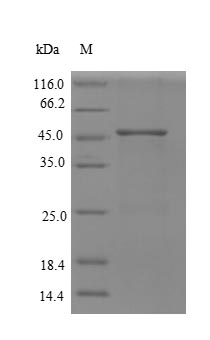This high-quality Recombinant Human RPA2 protein is an essential component for research in epigenetics and nuclear signaling. RPA2, also known as Replication protein A 32 kDa subunit (RP-A p32), is a vital subunit of the heterotrimeric Replication protein A complex, which plays a key role in DNA replication, repair, and recombination processes.
Our Recombinant Human RPA2 protein is expressed in E.coli, ensuring a partial protein length (1-267aa) that retains functionality. The N-terminal GST-tag facilitates efficient purification, while maintaining the protein's integrity and activity. With a purity greater than 90% as determined by SDS-PAGE, our RPA2 protein guarantees reliable and reproducible results in your research projects. Available in both liquid and lyophilized powder forms, our Recombinant Human RPA2 protein is poised to support your scientific discoveries.






